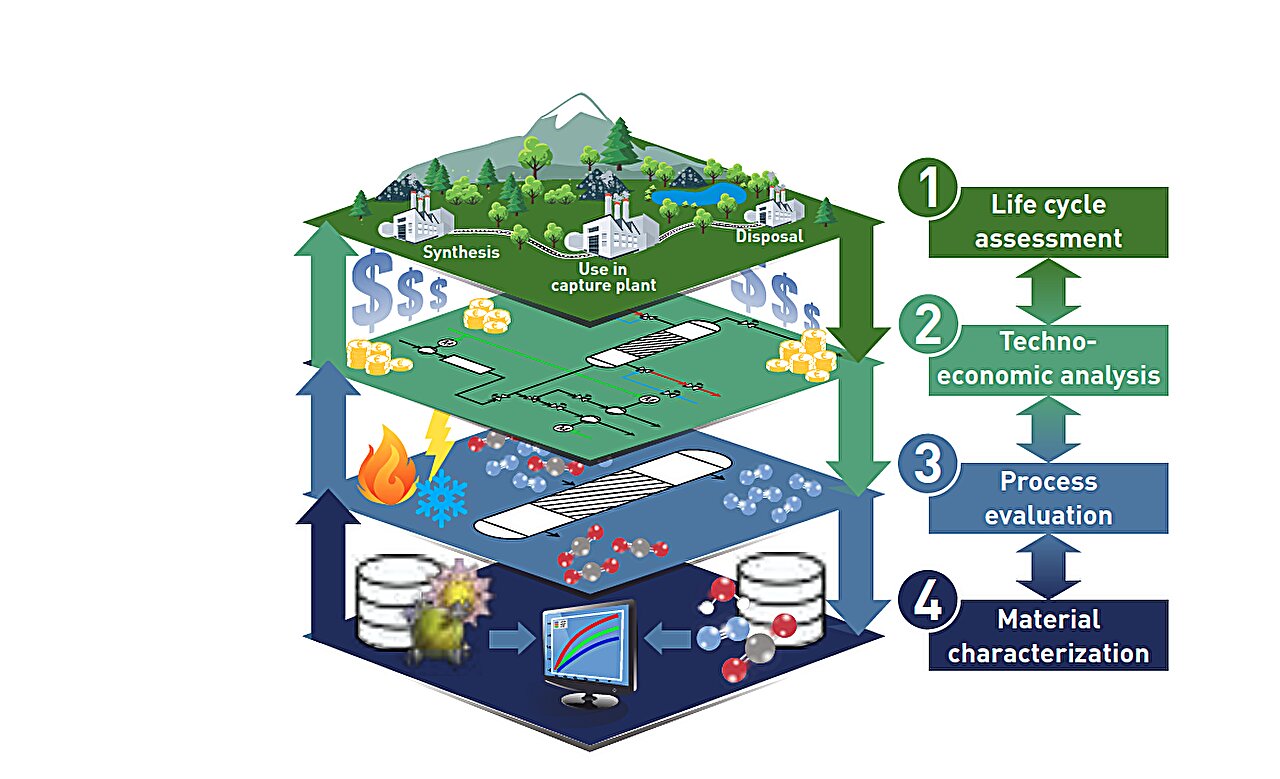Bridging the “valley of death” in carbon capture


The four layers of the PrISMa platform. Image credit: Ecole Polytechnique Federale de Lausanne
Mitigating the effects of climate change has become an important issue worldwide. Countries and international organizations are developing various strategies to solve the problem. Reducing CO2 Emissions are paramount, and carbon capture technologies are a promising way forward.
Yet bridging the gap between research and practical implementation of carbon capture solutions has proven so difficult that it actually has a name: the “valley of death.” The challenge is compounded by the need to consider the perspectives and priorities of various stakeholders throughout the process.
Traditionally, the development of carbon capture technologies begins with chemists designing materials and engineers developing processes, while the economic and environmental impacts are assessed later. The results are often suboptimal and only delay the implementation of real solutions.
In response, scientists led by Berend Smit at EPFL and Susana Garcia at Heriot-Watt University have developed the PrISMa (Process-Informed design of tailormade Sorbent Materials) platform: an innovative tool that seamlessly combines materials science, process design, techno-economics and life cycle analysis by considering the perspectives of multiple stakeholders from the outset.
Using advanced simulations and machine learning, PrISMa can identify the most effective and sustainable solutions and predict the performance of new materials, making it a powerful tool in the fight against climate change. The study was published in the journal Nature.
Evaluate KPIs
PrISMa evaluates four Key Performance Indicators (KPIs) or “layers” to assess the viability of a carbon capture material from its initial development to its implementation in a complete carbon capture plant.
- Material level: Using experimental data and molecular simulations, the platform predicts the adsorption properties of potential sorption materials.
- Process level: PrISMa calculates process performance parameters such as purity, recovery and energy requirements.
- Techno-economic analysis level: PrISMa assesses the economic and technical feasibility of a carbon capture plant.
- Life cycle assessment level: PrISMa assesses the environmental impacts over the entire life cycle of the plant, thus ensuring comprehensive sustainability.
Testing PrISMa using case studies
The scientists used PrISMa to compare over sixty real-world case studies in which CO2 is obtained from different sources in five world regions using different technologies. By considering different stakeholder perspectives, PrISMa helped to identify the most effective and sustainable solutions.
“One of the unique features of the PrISMa platform is its ability to predict the performance of new materials using advanced simulations and machine learning,” says Berend Smit. “This innovative approach accelerates the discovery of best-performing materials for carbon capture and outperforms traditional trial-and-error methods.”
Molecular simulations
The platform integrates density functional theory (DFT) and molecular simulation to predict material properties required for process design. The team tested this approach on a CO2 The indirect emissions of a capture plant were investigated over a period of 30 years and this was linked to a technical and economic evaluation in which the costs of the process were assessed.
“We have succeeded in linking the movement of electrons at the DFT level to calculate the total amount of CO2 can be separated over the 30-year lifetime of a capture plant and at what cost,” says Berend Smit.
The stakeholder perspective
PrISMa provides valuable insights to various stakeholders, provides engineers with the tools to design the most efficient and cost-effective carbon capture processes, and gives chemists guidance on the molecular properties that improve material performance.
Environmental managers gain access to comprehensive environmental impact assessments to make more informed decisions, while investors benefit from detailed economic analyses that reduce the risks and uncertainties associated with investing in new technologies.
Discover new materials
PrISMa can accelerate the discovery of the best performing carbon capture materials, outperforming traditional trial-and-error methods. Its interactive tools allow users to explore more than 1,200 materials and understand the trade-offs between cost, environmental impact and technical performance.
This comprehensive approach ensures that the solutions chosen are CO2 while minimizing the overall impact on the environment.
Smit envisions PrISMa being used, among other things, for the discovery of metal-organic frameworks (MOFs), porous materials with a wide range of applications, including carbon deposition. “The idea is that chemists can upload the crystal structures of their MOFs and the platform will evaluate these materials for all kinds of deposition processes,” he says. “This way, even chemists who do not have detailed knowledge of carbon deposition technologies can get feedback on which MOFs perform best and why.”
PrISMa can accelerate the development of carbon capture technologies and help achieve net zero emissions by bringing together all relevant stakeholders early in the research process. Through a comprehensive assessment of materials and processes, PrISMa enables better-informed decisions leading to the development of more effective and sustainable carbon capture solutions.
More information:
Charithea Charalambous et al, A holistic platform to accelerate sorbent-based carbon capture, Nature (2024). DOI: 10.1038/s41586-024-07683-8
Provided by the Ecole Polytechnique Federale de Lausanne
Quote: Bridging the “valley of death” in carbon capture (July 18, 2024), accessed July 18, 2024 from https://phys.org/news/2024-07-bridging-valley-death-carbon-capture.html
This document is subject to copyright. Except for the purposes of private study or research, no part of it may be reproduced without written permission. The contents are for information purposes only.

